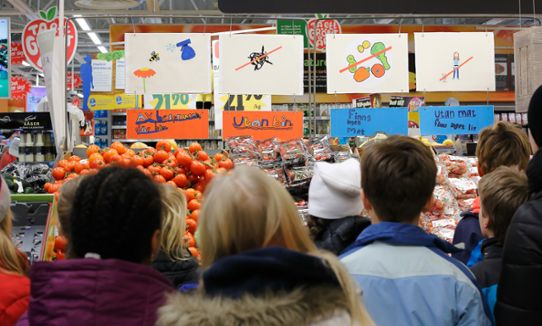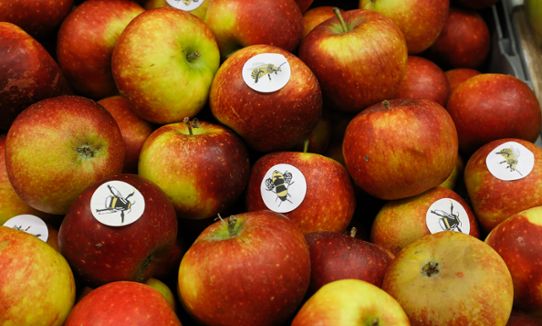The changed climate of the future will affect the supply of foodstuffs, partly due to harvests being affected by more extreme weather, such as drought and sudden cloudbursts of heavy rainfall. A warmer climate may also impact the transportation of foodstuffs. There is an additional risk that the distribution areas of pollinators will be affected by changes in the climate, as well as failings in coordination between the pollinators and the flowering of the plants.

In the project, Year 3 pupils have the chance to work together with the artist Malin Lobell (who also developed the project) to address different themes related to the concept of sustainability. The children learn about food production, and about how we eat and process food from farm to fork, and they develop their own solutions to the challenges facing society. The children themselves came up with the title of the project – “Hur blir det i framtiden?” – which poses the question of what the situation will be in the future. The future in general and changes to the climate present a complicated challenge for both adults and children, and here artistic methods are used to help simplify this complex reality.
As part of this project, the children work with different themes: climate, agriculture, farming, food, water, recycling, pollination, transport and biodiversity. This is in accordance with the school’s objective of incorporating the topic of sustainable development into its teaching. Teachers take responsibility for the theoretical aspects, and an artist engages with the children in the practical work. The project gives the children an insight into how artistic expression and artistic methods can be used to create stories and to encourage reflection on the topic of food as both a form of nutrition and a material, resources, the climate and our impact on the climate and health.
The structure has been used on two occasions in slightly different forms: first with Year 3 pupils at Högsätra skola in Lidingö, and then with Year 6 pupils at Rotskärsskolan in Skutskär.
The children were invited to develop their own ideas and solutions for various problems relating to the environment and climate change. One example of a solution that was developed concerned the future shortage of water in a changed climate. Because there is already a shortage of fresh water today, the solution was to use filters to remove the salt from salt water in order to produce fresh water.
The food supply was a recurring theme, addressing food waste and pollination. The group of Year 6 schoolchildren painted bees, which were then made into stickers. The pupils produced plant-based paint from food waste from grocery stores, which they then used in order to paint the bees.

An exhibition site with maximal reach
The exhibition site was chosen from the children’s perspective – with regard to both the site itself and to the site’s connection to the theme. A nearby grocery store gave the children the opportunity to present their exhibition to parents and friends in an environment that is related to the issues, thereby creating a direct link that makes it easier for the children to understand. The project also reaches out to more, indirect target groups – many people visit the grocery store at some point, and the children also become ambassadors for the knowledge they have learned during the project.
The various artworks were displayed around the store in the form of signs, labels and a range of installations over the period of one week. Art with a connection to the theme of pollination was displayed by the fruit and vegetables. The children raised awareness of products that are dependent on pollination by labelling them with their bee stickers. The filter that would convert salt water to fresh water was displayed by the water bottles. Cloth tote bags, which the children had sewn themselves together with their sewing teacher, were hung by the checkouts. A bicycle, which had been found in the school’s refuse room, was decorated and placed at the entrance to the store, to encourage shoppers to cycle to the store instead of taking the car. A globe and different animals were hung up to show how certain species have become endangered in different parts of the world as a result of climate change and the impact of other forms of human behaviour. The rest of the artworks were similarly strategically placed in related areas of the store.
Results
The artistic forms of expression helped to communicate knowledge to the children in a way that was fun, creative and easy to understand, and raised the children’s awareness of issues concerning food and the climate. The children were able to acquire a deeper understanding of the entire food cycle, and of their own and society’s impact on the climate and environment. Most importantly, the children were given the opportunity to serve as ambassadors, to raise awareness, and to exhibit their creative solutions.
More examples of climate adaptation
This is one of many examples of climate adaptation. There are more in the collection of ideas being built up by the Swedish National Knowledge Centre for Climate Change Adaptation at the Swedish Meteorological and Hydrological Institute (SMHI). The collection of examples has the aim of sharing experiences and providing ideas to everyone who works with climate adaptation. Examples describe concrete measures and challenges in several subject areas. They show how different actors have worked to adapt their activities to the climate changes that are already being noticed today and those that we cannot prevent in the future.